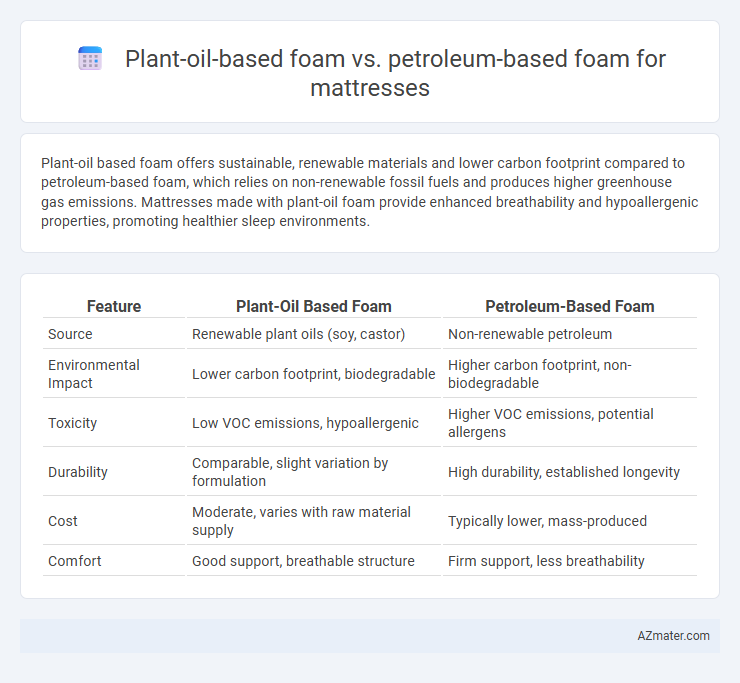Plant-oil based foam offers sustainable, renewable materials and lower carbon footprint compared to petroleum-based foam, which relies on non-renewable fossil fuels and produces higher greenhouse gas emissions. Mattresses made with plant-oil foam provide enhanced breathability and hypoallergenic properties, promoting healthier sleep environments.
Table of Comparison
| Feature | Plant-Oil Based Foam | Petroleum-Based Foam |
|---|---|---|
| Source | Renewable plant oils (soy, castor) | Non-renewable petroleum |
| Environmental Impact | Lower carbon footprint, biodegradable | Higher carbon footprint, non-biodegradable |
| Toxicity | Low VOC emissions, hypoallergenic | Higher VOC emissions, potential allergens |
| Durability | Comparable, slight variation by formulation | High durability, established longevity |
| Cost | Moderate, varies with raw material supply | Typically lower, mass-produced |
| Comfort | Good support, breathable structure | Firm support, less breathability |
Introduction to Mattress Foam Types
Plant-oil based foam utilizes renewable resources such as soybean or castor oil, offering eco-friendly alternatives with improved breathability and reduced chemical emissions compared to traditional petroleum-based foam. Petroleum-based foam, primarily made from polyether or polyester polyols derived from fossil fuels, provides high durability and consistent support but raises concerns regarding environmental impact and off-gassing. Advancements in plant-oil formulations aim to match the performance of petroleum foams while enhancing sustainability in mattress production.
What is Plant-Oil Based Foam?
Plant-oil based foam is a type of polyurethane foam made by replacing a portion of petroleum-based polyols with renewable plant-derived oils such as soy, castor, or palm oil. This sustainable alternative to traditional petroleum-based foam offers comparable comfort and durability while reducing reliance on fossil fuels and lowering environmental impact. The bio-based content in plant-oil foam contributes to reduced carbon footprint and improved eco-friendliness in mattress production.
What is Petroleum-Based Foam?
Petroleum-based foam is a type of mattress foam derived from petrochemicals, primarily using polyurethane from crude oil. It offers durability, high density, and consistent support, commonly utilized in traditional mattresses for its resilience and cost-effectiveness. However, petroleum-based foam lacks biodegradability and has a higher environmental footprint compared to plant-oil based alternatives.
Sustainability and Environmental Impact
Plant-oil based foam mattress materials significantly reduce reliance on non-renewable petroleum resources, lowering carbon emissions and promoting biodegradable waste management. These foams often incorporate soybean or castor oil, which enhance renewable sourcing and decrease environmental toxicity compared to traditional petroleum-based foams. Sustainable production processes and improved end-of-life disposal options make plant-oil foams a greener alternative for eco-conscious mattress manufacturing.
Health and Safety Considerations
Plant-oil based foam mattresses reduce exposure to toxic chemicals and volatile organic compounds (VOCs), promoting better indoor air quality and minimizing respiratory irritations. Petroleum-based foams often release higher levels of VOCs and may contain flame retardants linked to potential health risks, including endocrine disruption and allergies. Choosing plant-oil based foam supports a safer sleep environment by lowering the risk of chemical off-gassing and enhancing overall mattress safety.
Comfort and Performance Comparison
Plant-oil based foam mattresses offer superior breathability and enhanced pressure relief due to their open-cell structure, promoting better airflow and cooler sleep compared to petroleum-based foam. Petroleum-based foam typically provides firmer support but can retain heat and degrade faster over time, impacting durability and comfort consistency. Performance tests indicate plant-oil foams maintain resilience and comfort longer, reducing off-gassing and environmental impact while delivering comparable support levels.
Durability and Longevity
Plant-oil based foam mattresses exhibit enhanced durability due to their natural composition, which resists oxidation and breakdown better than petroleum-based foam. The bio-based polyols in plant-oil foams provide improved cell structure stability, extending mattress lifespan compared to conventional petroleum foams prone to faster wear and tear. Longevity studies reveal plant-oil foam mattresses maintain firmness and support over 8 to 10 years, outperforming petroleum-based counterparts that often degrade within 5 to 7 years.
Cost and Market Availability
Plant-oil based foam for mattresses offers a competitive price point that is gradually decreasing as production scales, but it currently remains slightly higher than traditional petroleum-based foam. Market availability of petroleum-based foam is widespread and well-established due to decades of dominance in the mattress industry, whereas plant-oil based foam is expanding rapidly, driven by consumer demand for sustainable and eco-friendly materials. Cost efficiency and broader supply chains keep petroleum-based foam dominant, while innovations in plant-oil foam manufacturing are improving accessibility and price parity.
Consumer Trends and Preferences
Consumers increasingly prefer plant-oil based foam mattresses due to their eco-friendly credentials and reduced reliance on fossil fuels. Market analytics reveal a rising demand for sustainable materials, with plant-oil foams offering enhanced breathability and hypoallergenic properties compared to petroleum-based counterparts. Surveys indicate younger demographics prioritize natural components and environmental impact, driving a notable shift in mattress industry innovation and consumer purchasing behavior.
Future Outlook for Mattress Foam Technologies
Plant-oil based foam is gaining traction in mattress foam technologies due to its sustainable sourcing and lower carbon footprint compared to traditional petroleum-based foam. Innovations in bio-based polyols and advanced foam formulations are enhancing durability, comfort, and performance, positioning plant-oil foams as a viable alternative for eco-conscious consumers. Market projections indicate a significant growth in the adoption of bio-based foam materials, driven by increasing environmental regulations and consumer demand for greener mattress options.

Infographic: Plant-oil based foam vs Petroleum-based foam for Mattress
 azmater.com
azmater.com